Shefqet Avdush Emini – A Journey Through Spiritual Transparency and Traces of Memory in the Painting "Untitled", 2008
The painting Untitled, created in 2008 by the artist Shefqet Avdush Emini, is a profound journey into the realms of human sensitivity—a delicate yet powerful reflection on solitude, hope, and the constant presence of memory in our lives. In this work, Emini manages to convey a rare sensitivity through an interplay of abstract and figurative language, masterfully intertwined to create a metaphysical and mystical atmosphere.
The visual composition consists of two elongated female figures in the foreground, almost transparent in parts of their bodies, like beings who carry memories of the past—silhouettes of the soul belonging to another time, to a lost or unnamed world. These figures are shaped by loaded brushstrokes and a palette of deep, contrasting colors—dark blue, damp green, violet, and black—which starkly oppose the golden-yellow and calm blue background. This chromatic contrast positions the painting in a tensioned dimension between light and darkness, between life and memory, between the physical and the spiritual.
In the background, an architectural form resembling a church or a sacred building—rendered vaguely and ambiguously—adds a sacred, almost spiritual dimension to the work. It evokes a symbol of eternity, a holy place where the forgotten souls remain close and follow the eternal rhythms of existence. While the foreground figures move slowly, almost frozen in time, the architecture in the distance appears like a silent guide, a reference point for the past and for an unquenchable longing.
The bodies of the figures are not clearly defined; they partially merge with the background, conveying a sense of impermanence—as if they are temporary visitors in this world or perhaps remnants of a memory trying to live on through art. Their facelessness liberates them from personal identity, elevating them to universal representations of womanhood, of the human spirit, of collective memory. This absence of portraiture, a hallmark in Emini’s oeuvre, emphasizes his philosophical intent: a person is more than a face; they are what they carry in their soul and mind.
The chromatic palette is essential in conveying the emotion of the painting. The yellow background symbolizes light—a kind of inner illumination or hope—while the deep blues and greens speak of introspection, of spiritual depth, and of the uncertainty of the journey we make through memory. Emini’s technique is bold, with strong but controlled brushstrokes that create both structure and fluidity. He constructs space not through traditional perspective, but through color and form that melt and layer like complex thoughts or repressed emotions.
This painting can be read as an allegory of the ever-present, unspoken memories—of feelings that need no words but seek form through art. The two figures mirror each other, perhaps two women from the same path of life, perhaps past and future meeting in an eternal moment. They could be sisters, mother and daughter, or simply two souls bearing the same emotional burden in a world that has forgotten them.
In this work, Emini constructs a visual poetry that is both painful and beautiful. He does not seek to explain the world through realistic details, but to invite us to feel beyond reality. This is the essence of his art—to help us see through the visible layers of life toward something deeper, more intricate, and more truthful.
Ultimately, Shefqet Avdush Emini’s Untitled remains a metaphor for humanity’s journey in search of meaning—for the silent dialogue between spirit and memory, between past and future, between the visible and the invisible. It is a work that speaks through silence and invites us to listen to what stirs in the depths of our inner selves—where art finds its truest home.
"Untitled", 2008, by Shefqet Avdush Emini
In the philosophical approach that Shefqet Avdush Emini presents through this painting, we encounter not only an aesthetic expression but a spiritual document that allows us to uncover layers of the human subconscious. His art is never a surface meant to please the eye; on the contrary, it is an invitation to enter a world where vision, emotion, and experience are interwoven into a shared meditative act.
The painting Untitled can be seen as a long path toward visual devotion. The figurative aspect is restrained and selective; it does not overcrowd the space, but rather uses the vacuum to build the intensity of presence. The elongated, almost mutilated figures are themselves declarations of the fragility of existence. They do not require portraits, facial expressions, or eyes to look at us—because their strength lies in the silent presence they embody.
Within that silence, Emini articulates a new language of art—a language in which emotions are communicated through the intensity of color, the tension of form, and the silence sensed in the separations of hue. The blues and greens in the lower part of the composition form a terrain that is simultaneously land and water, perhaps an in-between landscape, an existential limbo where these figures move without destination, but with a deeper purpose: to bear witness to their existence in silence.
Figures as Symbols of Humanity After Tragedy
By viewing these figures as bearers of a collective history, we can also interpret the painting as a reflection on loss, war, and its consequences on human life. Shefqet Avdush Emini, who has personally experienced the aftermath of the violent disintegration of his homeland, brings a profound sensitivity to human suffering through his art. These unnamed silhouettes are silent witnesses to history—women walking through the ruins of the human soul, wearing traces of sorrow in their garments, but also untouched hopes.
Beyond Aesthetics: Ethics, Metaphysics, and the Poetic Power of Painting in Shefqet Avdush Emini's Work
In this regard, the painting transcends aesthetic boundaries to enter an ethical and metaphysical territory. It is not merely an image — it is a stance toward the world. Emini does not offer us a linear narrative, but a space to reflect on what is usually left unsaid: the silence of victims, the eternal longing, the absence that becomes presence. The two figures act as symbols for all the women who have lost — children, husbands, homelands — but have not lost their spirit, who have never stopped moving forward.
The Transhistorical and Universal Dimension of the Female Figure
In a broader interpretation, the female figure in the painting “Untitled” becomes a symbol of the life-bearing force. They are not merely individual women — they are emblems of motherhood, continuity, endurance, and resilience. In a world where women have so often been the subjects of oppression or unspoken sorrow, Emini grants them an undeniable presence and a visual authority.
These figures are stable, though faint and translucent. They stand in a landscape that is neither fully terrestrial nor celestial — it is a place in between. This liminal landscape represents the space between time and eternity, between life and remembrance, a place where the soul outweighs the body.
Here lies Emini’s genius: the ability to express through painting not merely an image, but a spiritual state, a universal sensation, an experience that transcends time and place.
Technique as a Poetic Instrument
The technique used in this painting is an essential part of its inner communication. The colors are not applied decoratively, but are imbued with emotional tension and narrative weight. They create an atmosphere that absorbs the viewer and immerses them in the universe of the work. The way the background melts into the figures, and how the bodies partially dissolve into a timeless transparency, gives the sense that everything in this painting is in transition — nothing is permanent, everything is passing.
The brushstrokes are not hidden. They are visible, intentional, as if they were marks of an effort to capture something that is disappearing, to preserve a moment before it fades. This is another element that ties the work to the poetics of memory — everything in this painting feels like a fading memory, yet one that refuses to be forgotten.
A Metaphor for Humanity's Spiritual Journey
In conclusion to this multifaceted analysis, “Untitled” is not merely a work of art, but a reflection on the state of being. It can be seen as an invisible chronicle of the contemporary human, who moves forward through unclear territories, relying only on the strength of the spirit and the hope that, despite the darkness, there is light somewhere beyond.
Shefqet Avdush Emini, with rare mastery, creates a deep dialogue with both the visible and the invisible. He does not provide answers, but instead leads us toward great questions. On this journey, such figures — simple in appearance, yet laden with symbolism and depth — remind us that art is not just visual, but an act of understanding oneself and the world around us.
In this way, “Untitled” becomes an eternal document of the human spirit, a testament to sensitivity and to the transformative power of art. It stands not only as the work of a great artist, but as a call to never forget the essence of what we are — beings in search of meaning, of hope, and of a love that remains, even when everything else fades.
The Profound Human Sensitivity in Emini’s Work
Shefqet Avdush Emini possesses a deep sensitivity for the human being, and this is one of the most prominent qualities of his art.
At the heart of his creativity stands the human being in all their existential states — wounded, lost, abandoned, yet always with an inner hope that shines through the darkness. Emini does not envision human figures merely as physical forms; he treats them as bearers of deep emotions, historical memory, and spiritual experience. In many of his works, the characters are bowed, translucent, silent — as if to remind us of the fragility of life and the weight of pain that is often carried in silence.
His sensitivity is not sentimental, but profound, philosophical, and often ethical. He does not portray suffering to shock, but to reflect on the meaning of life and the value of every human being in a world that often forgets to pause and listen.
Through his work, Emini gives voice to the unspoken — to those who cannot speak, to those who have been forgotten, to those who walk through history as shadows, but who in his paintings take on form and weight. This speaks to a sensitive soul and an artistic conscience that is deeply humane and universal.
In this respect, Shefqet Avdush Emini is not only a painter, but also a witness of human emotions and a guardian of humanity's spiritual memory.
Honesty, Emotion, and the Spiritual Integrity of Emini’s Art
Shefqet Avdush Emini expresses a sincere and profound sense toward the human being and their lived reality, and this sincerity makes his art extraordinary, moving, and authentic.
In his works, there are no masks. There are no unnecessary embellishments that distract from the truth of human experience. He does not hide behind formalism or empty aestheticism. On the contrary, every line, every color, every distorted form is a pure act of artistic honesty, a visual testimony that invites us to confront what we are — beautiful in our fragility, grand in our pain, and undefeated in the midst of loss.
The human figure in Emini's paintings is not perfect, because life is not perfect. It is often dark, bent, deformed — but always sensitive, alive, and true. This emotional realism — an inner realism, not necessarily figurative — is proof of an art that arises from direct experience of life, not from theoretical speculation.
Shefqet Avdush Emini does not paint to impress — he paints to tell a truth. A truth he has felt, seen, perhaps lived. And this sincere feeling for humanity is not sentimental, but the fever of conscience, a pain that seeks to be understood, to be heard, to never be forgotten.
In each of his works we find an honest dialogue between the artist and human reality, a constant effort to capture the essence of human experience — with all its contrasts: light and darkness, strength and fragility, silence and hidden cries.
This is the rare sincerity that only an artist with profound life experience and extraordinary sensitivity can achieve. And Shefqet Avdush Emini has done this consistently and steadfastly throughout his creative life.
A Legacy of Human Depth and Artistic Integrity
Shefqet Avdush Emini is one of those creators who deserves deep appreciation, not only as a great artist, but also as a person with rare sensitivity and high spiritual integrity. He is not just a name in the art world, but a powerful voice of human conscience, a mirror of our collective experience, and living proof of how art can...
In this context, the painting transcends aesthetic boundaries to enter an ethical and metaphysical territory. It is not merely an image — it is a stance toward the world. Emini does not offer us a linear narrative, but a space to reflect on what is usually left unsaid: the silence of the victims, the eternal longing, the absence that becomes presence. The two figures serve as symbols of all women who have suffered loss — children, husbands, homelands — but who have not lost their spirit, who have not ceased to move forward.
The transhistorical and universal dimension of the female figure
In a broader interpretation, the female figure in the painting "Untitled" becomes a symbol of the life-bearing force. These are not merely individual women — they are emblems of motherhood, continuity, patience, and resilience. In a world where women have so often been the subject of oppression or inexpressible sorrow, Emini grants them undeniable presence and visual authority. These figures remain steadfast, though pale and translucent. They stand in a landscape that is neither entirely earthly nor celestial — it is a space in between. This liminal landscape represents the boundary between time and eternity, between life and memory — a place where the soul carries more weight than the body.
Here lies the genius of Emini: the ability to express through painting not simply an image, but a spiritual state, a universal sensation, an experience that transcends the boundaries of time and place.
Technique as a poetic instrument
The technique used in this painting constitutes a vital element of its internal communication. The colors are not applied decoratively; they are saturated with emotional tension and narrative. They create an atmosphere that draws the viewer in and immerses them in the universe of the work. The way the background blends with the figures, and the partial dissolution of the bodies into a timeless transparency, evokes a feeling that everything in this painting is in transition — nothing is permanent, everything is passing.
The brushstrokes are not hidden. They are visible, intentional — as if they were traces of an effort to capture something fading, to preserve a moment before it disappears. This is another element that links us to the poetics of memory — everything in this painting appears as a memory that is fading, but refuses to be forgotten.
A metaphor for humanity’s spiritual journey
As a conclusion to this multifaceted analysis, “Untitled” is not just a work of art, but a meditation on the human condition. It can be read as an invisible chronicle of the contemporary human being, who moves forward through uncertain terrains, supported only by the strength of the spirit and by the hope that, despite the darkness, there is light somewhere beyond.
With rare mastery, Shefqet Avdush Emini creates a profound dialogue between the visible and the invisible. He does not offer answers but guides us toward essential questions. In this journey, such figures — seemingly simple, yet laden with symbolism and depth — remind us that art is not merely visual, but an act of understanding ourselves and the world around us.
In this way, “Untitled” becomes a timeless document of the human soul, a testament to the sensitivity and transformative power of art. It stands not only as the work of a great artist but as a call to never forget the essence of what we are — beings in search of meaning, of hope, and of the love that remains even when everything else fades away.
Shefqet Avdush Emini possesses a profound sensitivity toward the human being, and this is one of the most prominent features of his art. At the center of his creative universe is the human being in all their existential states — wounded, lost, abandoned — yet always with an inner hope that shines through the darkness.
Emini does not envision the human figure merely as a physical form; he treats it as a bearer of deep emotions, historical memory, and spiritual experience. In many of his works, the characters are bent, translucent, silent — as if to remind us of the fragility of life and the weight of pain often carried in silence.
His sensitivity is not sentimental, but profound, philosophical, and often ethical. He does not depict suffering to shock, but to reflect on the meaning of life and the value of every human being in a world that too often forgets to pause and to listen.
Through his work, Emini gives voice to the voiceless — to those who cannot speak, to those who have been forgotten, to those who walk through history as shadows, but who in his paintings gain form and substance. This reveals a sensitive soul and an artistic conscience that is deeply humane and universal.
In this sense, Shefqet Avdush Emini is not just a painter, but a witness to human emotions and a guardian of the spiritual memory of humanity. He expresses a sincere and profound sense for the human being and their lived reality, and this sincerity makes his art extraordinary, moving, and authentic.
There are no masks in his work. There are no unnecessary embellishments that distance us from the truth of human experience. He does not hide behind formalism or empty aestheticism. On the contrary, every line, every color, every distorted form is an act of pure artistic honesty — a visual testimony that invites us to confront what we are: beautiful in our fragility, grand in our pain, and undefeated in the midst of loss.
The human figure in Emini’s paintings is not perfect, because life is not perfect. It is often somber, bowed, deformed — but always sensitive, alive, and true. This emotional realism — an inner realism, not necessarily a figurative one — testifies to an art born from direct life experience, not theoretical speculation.
Shefqet Avdush Emini does not paint to impress — he paints to tell a truth. A truth he has felt, seen, perhaps lived. And this sincere feeling for humanity is not sentimentalism, but the fever of conscience, a pain that seeks to be understood, heard, and not forgotten.
In every one of his works, we find an honest dialogue between the artist and human reality — a constant effort to capture the essence of human experience, with all its contrasts: light and darkness, strength and fragility, silence and hidden scream. This is the rare sincerity that only an artist with deep life experience and extraordinary sensitivity can achieve. And Shefqet Avdush Emini has achieved this consistently and with great integrity throughout his creative life.
Shefqet Avdush Emini is one of those creators who deserves to be deeply appreciated — not only as a great artist, but as a person of rare sensitivity and high spiritual integrity. He is not merely a name in the art world, but a powerful voice of human conscience, a mirror of our collective experience...
From Europe to Asia, from Africa to the Americas—and above all—deeply connected to the human reality, not merely to artistic trends. He does not follow trends to appear current; he creates faithfully, guided by his inner vision, by human pain and hope. As a person, he is a figure of profound sensitivity and strong character. Being a true artist is not merely a matter of talent, but a matter of honesty, dedication, and humanism. Emini is a man who remains loyal to his roots, yet thinks globally. He is a figure who carries Albanian culture with dignity and pride around the world, representing it not just as an identity, but as a profound spiritual and ethical experience.
In his interaction with people, he does not stand above them as an artist detached from reality, but builds bridges of dialogue and understanding, as a simple, humble, and open person. This human humility only magnifies his greatness as a creator.
His value is to be recognized:
For his unwavering dedication to art over decades.
For the way he has shaped human pain and hope—without clichés, without compromises.
For his influence in contemporary international art, as an authentic voice of both the Balkan and universal soul.
For his creative integrity, which stays far from hollow commercialism.
For his ability to touch the soul of every person, beyond language, nation, or personal history.
For his unwavering dedication to art over decades.
For the way he has shaped human pain and hope—without clichés, without compromises.
For his influence in contemporary international art, as an authentic voice of both the Balkan and universal soul.
For his creative integrity, which stays far from hollow commercialism.
For his ability to touch the soul of every person, beyond language, nation, or personal history.
In a time when art often loses its essence in a world accelerated by consumerism and superficiality, Shefqet Avdush Emini is proof that true art is still possible—art that springs from pain, from a love of life, from human sensitivity, and from a profound philosophical vision.
To appreciate Shefqet Avdush Emini means to appreciate one of the most important voices of the artistic conscience of our time. He is a cultural treasure who deserves his place in the history of world art.
Shefqet Avdush Emini is a renowned and internationally acclaimed artist. He has built an extensive international career spanning decades of continuous creativity, with ongoing participation in exhibitions, biennials, symposiums, and cultural events in over 30 countries across the world—from Europe to Asia, from the Americas to Africa.
Key highlights of his international recognition and fame:
Numerous international exhibitions in countries such as France, Italy, the Netherlands, Germany, the USA, Canada, South Korea, China, Japan, Egypt, Morocco, Turkey, Poland, Russia, Slovakia, and many others.
Participation in major international art biennials and symposiums, often invited as a special guest, honorary figure, or as the “highlight” of prestigious events.
Selected works included in museum, private, and institutional collections worldwide.
Dignified representation of Albanian and Balkan culture in a global context, making him an ambassador of the art and spirit of this region.
His recognition is not merely quantitative but deeply qualitative. Emini is not famous simply for the number of exhibitions, but for the power of his artistic message, his distinctive style, and the depth with which he penetrates the universal human experience.
Art critics, curators, collectors, and fellow artists recognize and respect his work for its originality, sincerity, and philosophical depth.
His name is associated with:
Expressive abstraction with a strong human feeling,
Art as testimony and ethical protest against injustice and human tragedy,An authentic style that imitates no one, carrying the personal imprint of a conscious and sensitive artist.
In the world of contemporary international art, Shefqet Avdush Emini is a well-established figure—a name featured in books, catalogs, and archives of important contemporary art institutions. He is an artist who has left a mark and continues to influence, inspiring new generations of creators.
Shefqet Avdush Emini is a globally recognized and celebrated artist. His fame is not built on noise, but on substance, value, dedication, and a profound artistic vision that transcends geographic and cultural boundaries. His name belongs not only to Albanian art but to the global contemporary art scene.

.jpg)







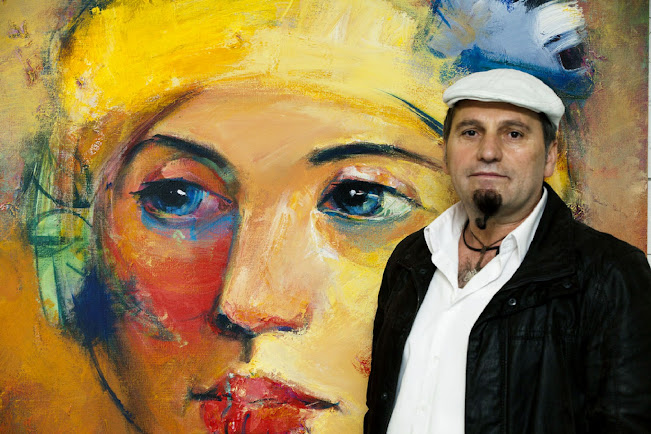






.jpg)

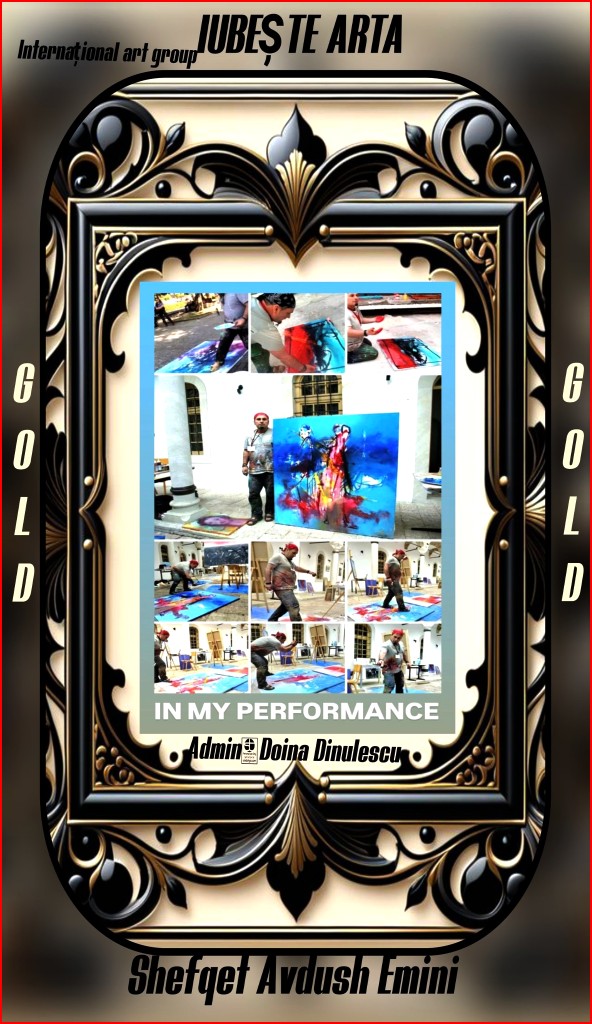








































.jpg)







.jpg)













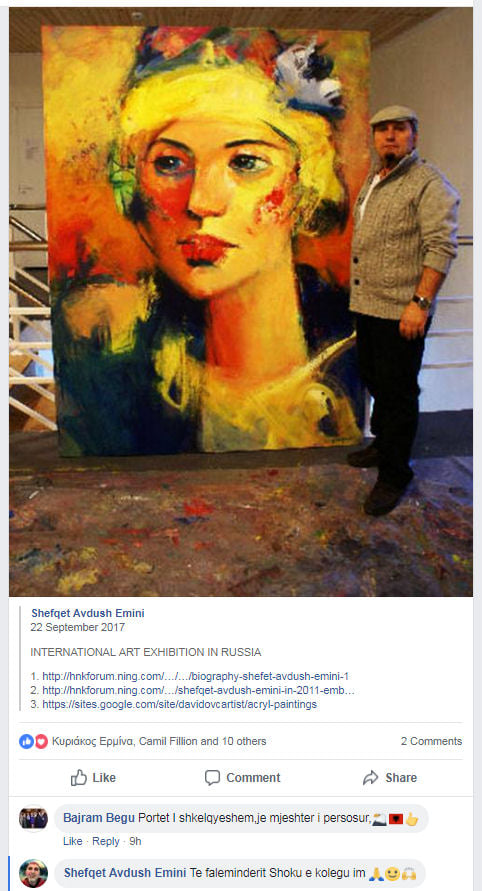



.png)












.png)


.jpg)

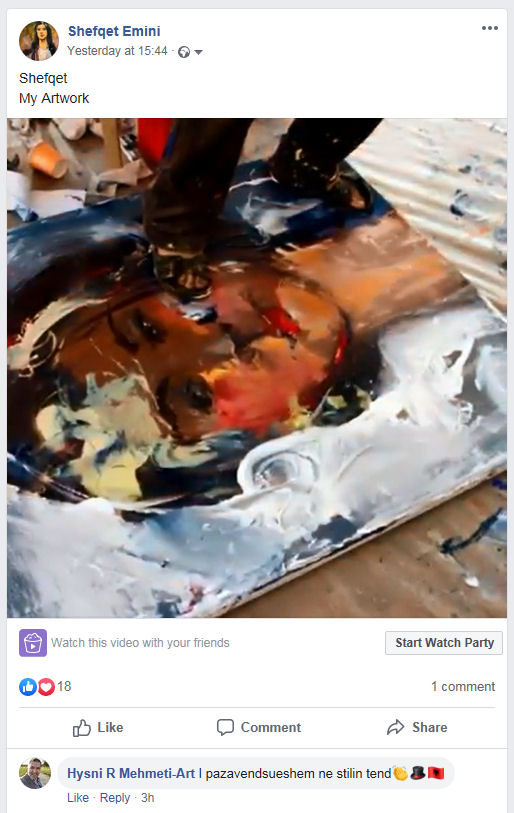

.jpg)
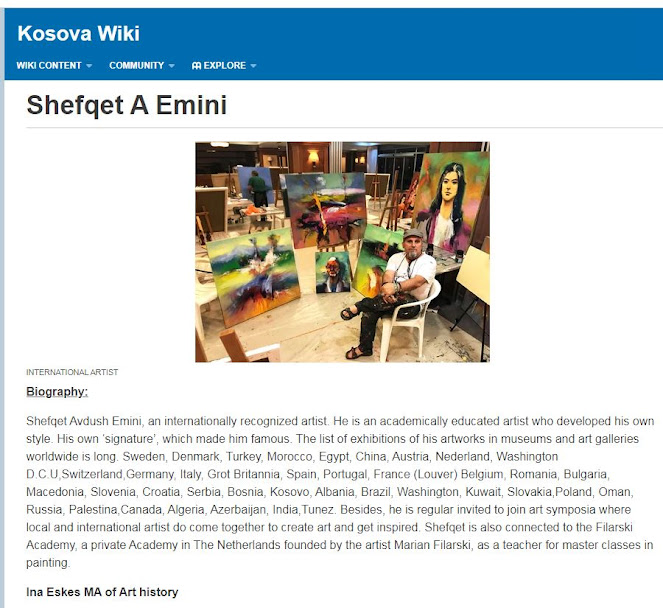

.JPG)



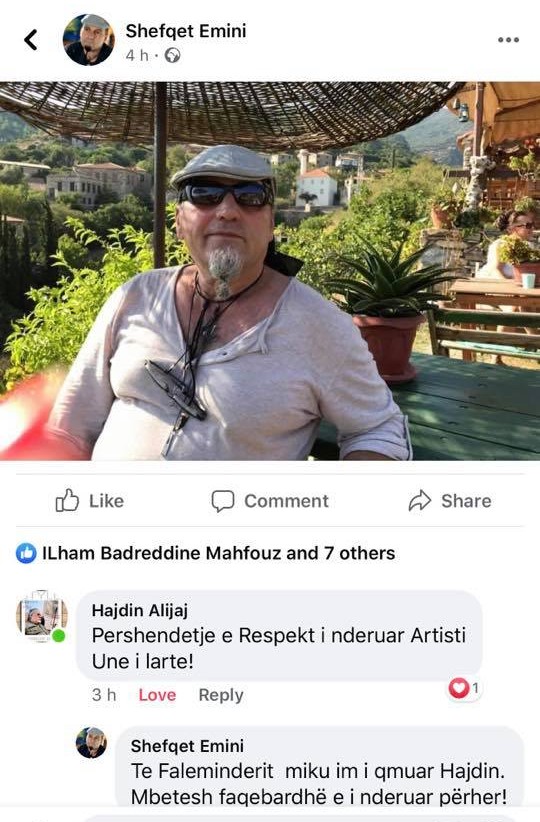

































.jpg)



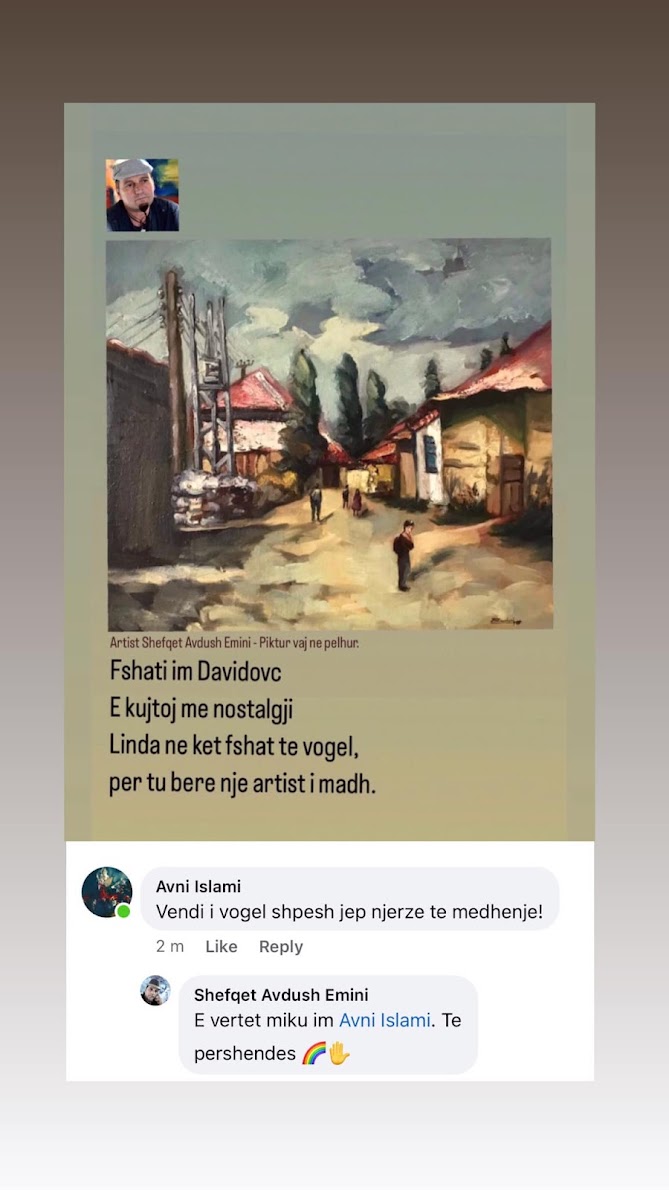




















.jpg)




.jpg?profile=RESIZE_710x)







.jpg?profile=RESIZE_710x)

















.png?profile=RESIZE_710x)









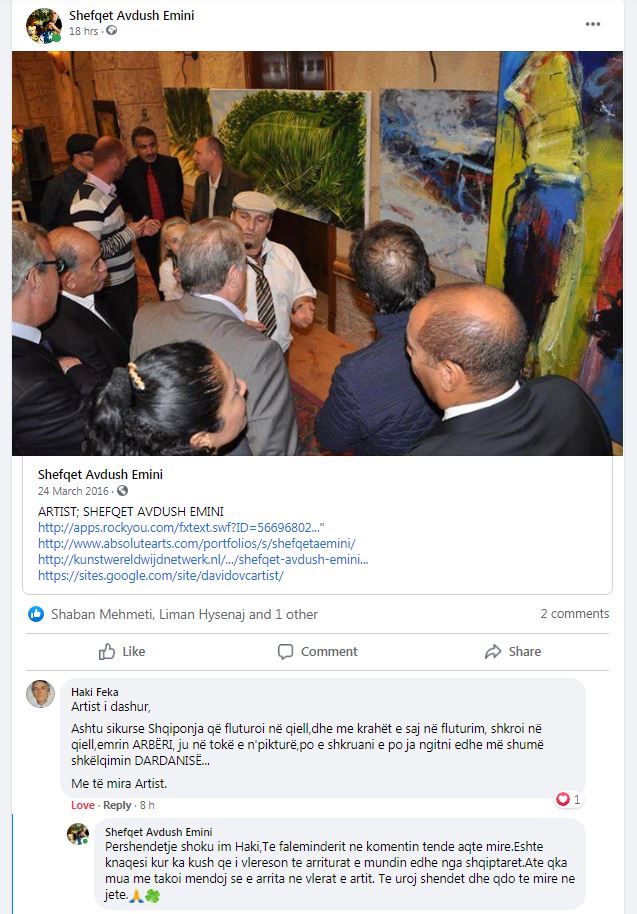

.png?profile=RESIZE_710x)


.jpg?profile=RESIZE_710x)



.jpg?profile=RESIZE_710x)




























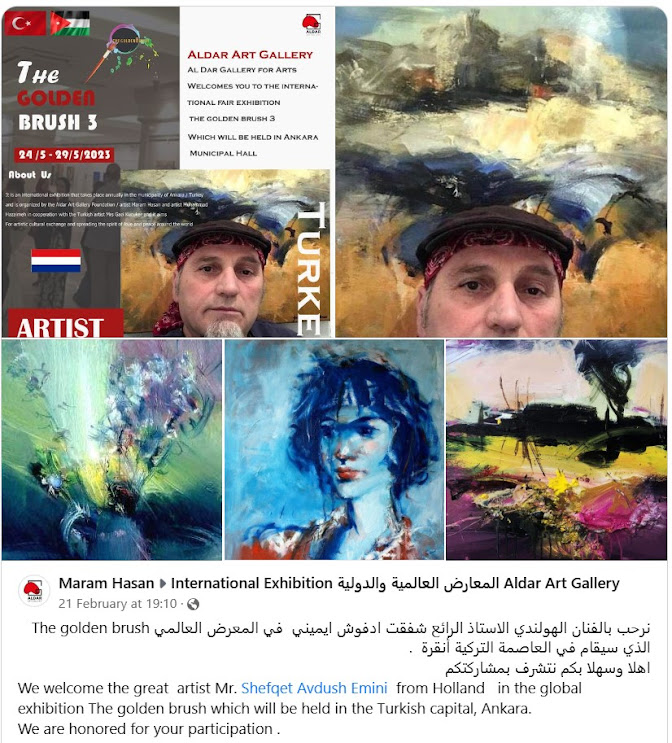


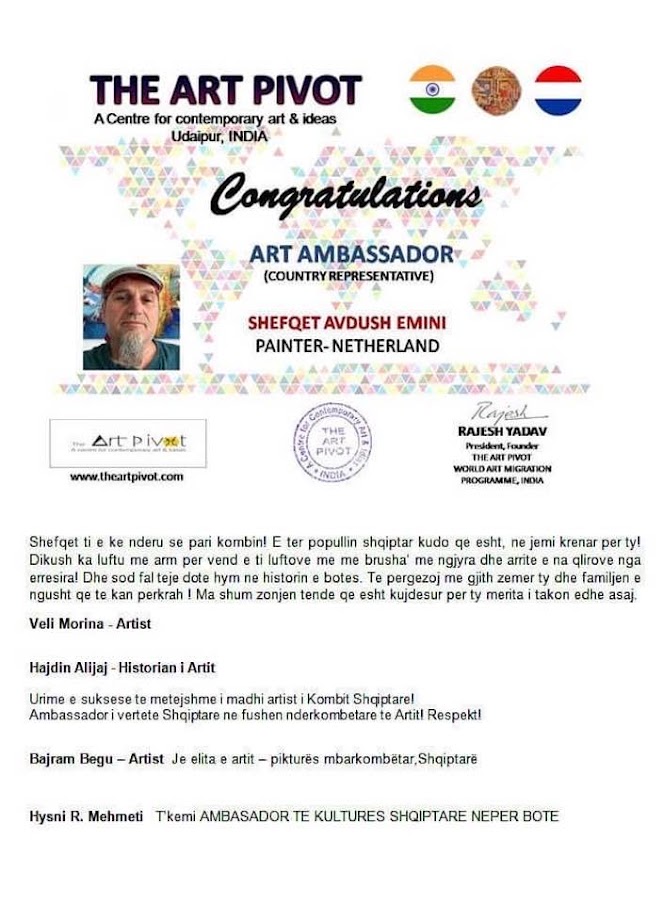


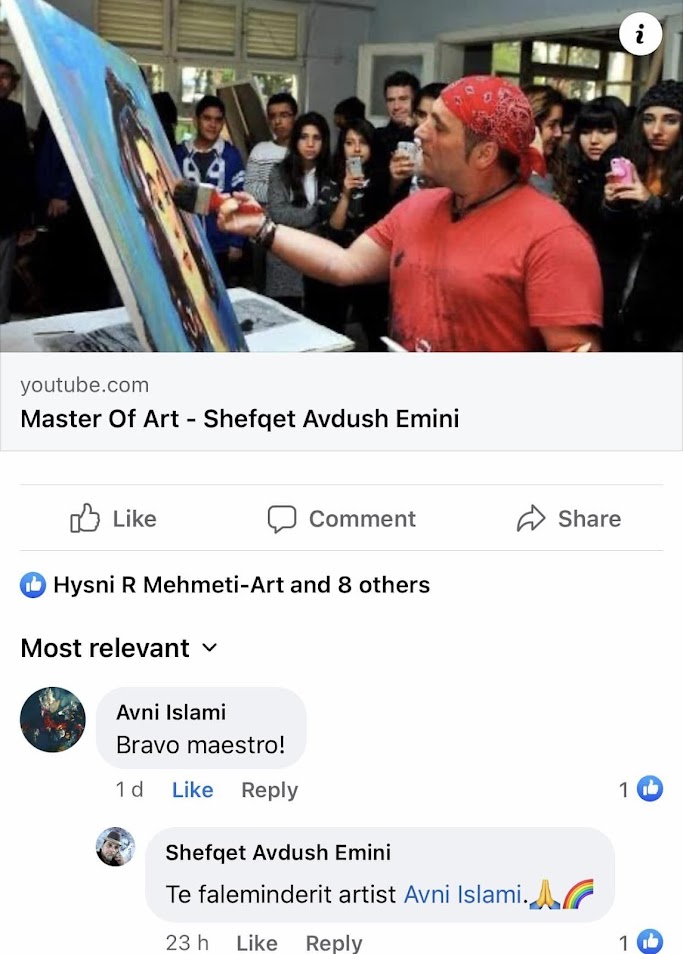


.jpg?profile=RESIZE_710x)














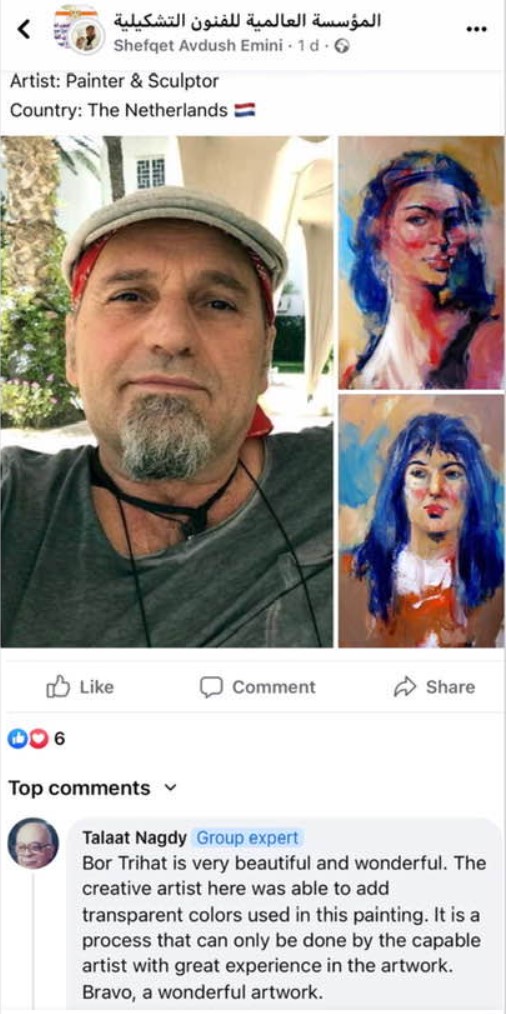








.jpg?profile=RESIZE_710x)



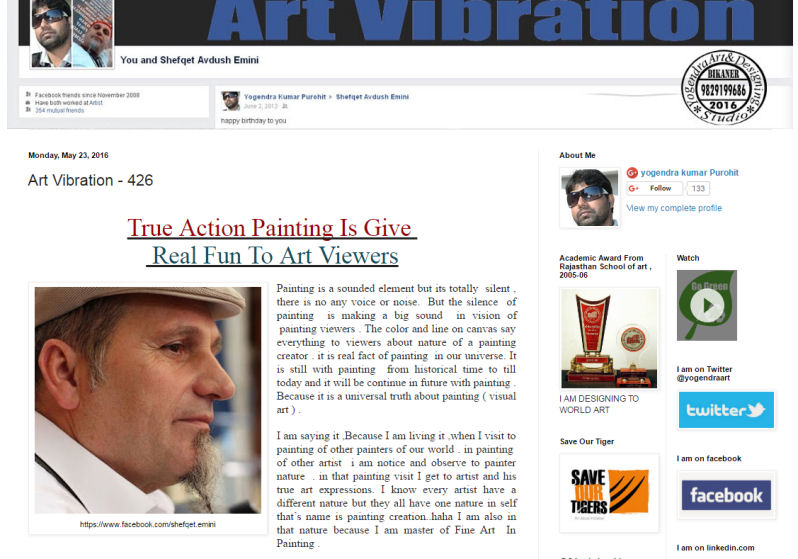
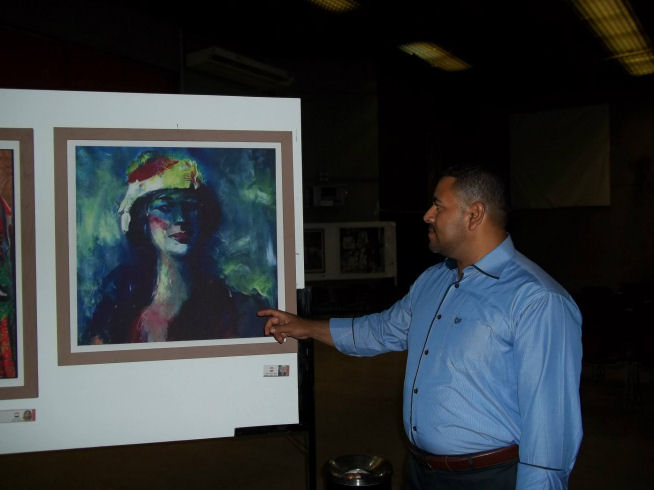
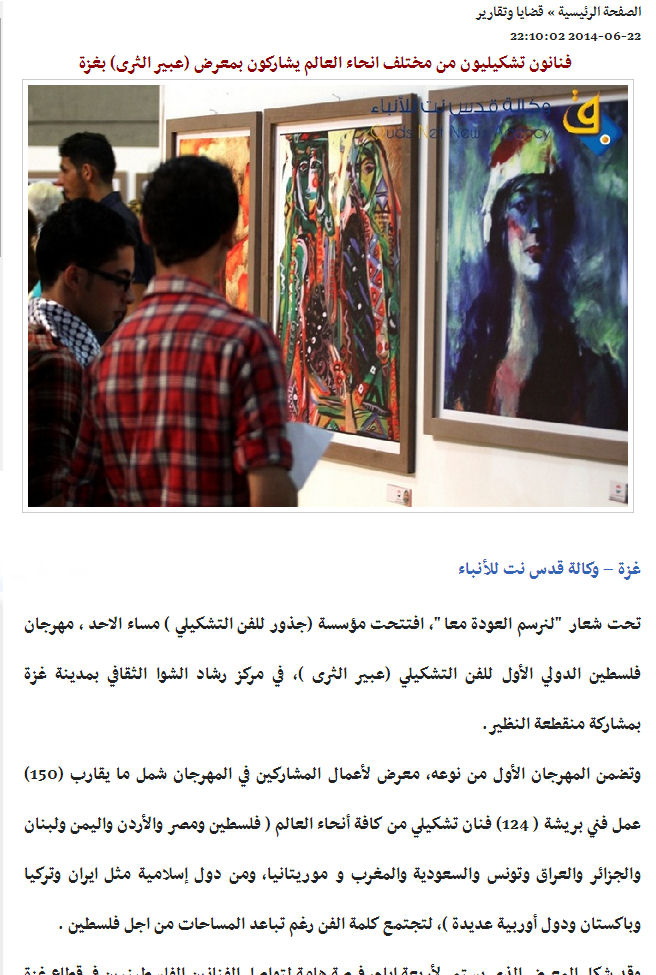
.jpg?profile=RESIZE_710x)
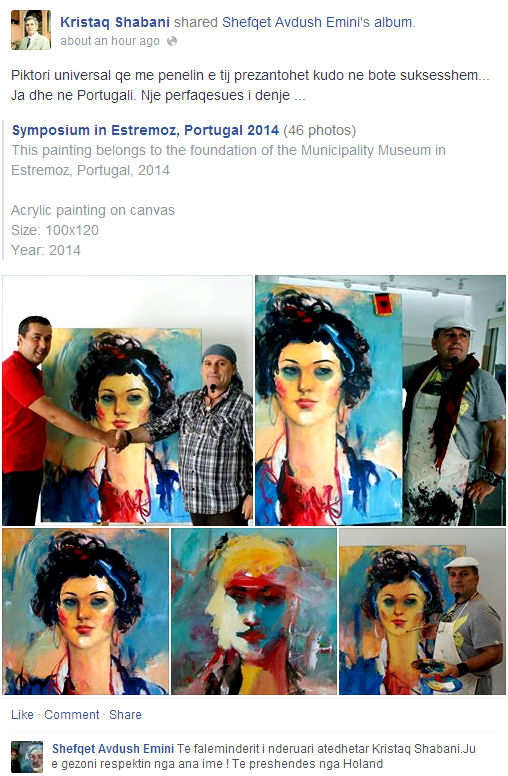
.jpg?profile=RESIZE_710x)
.jpg?profile=RESIZE_710x)
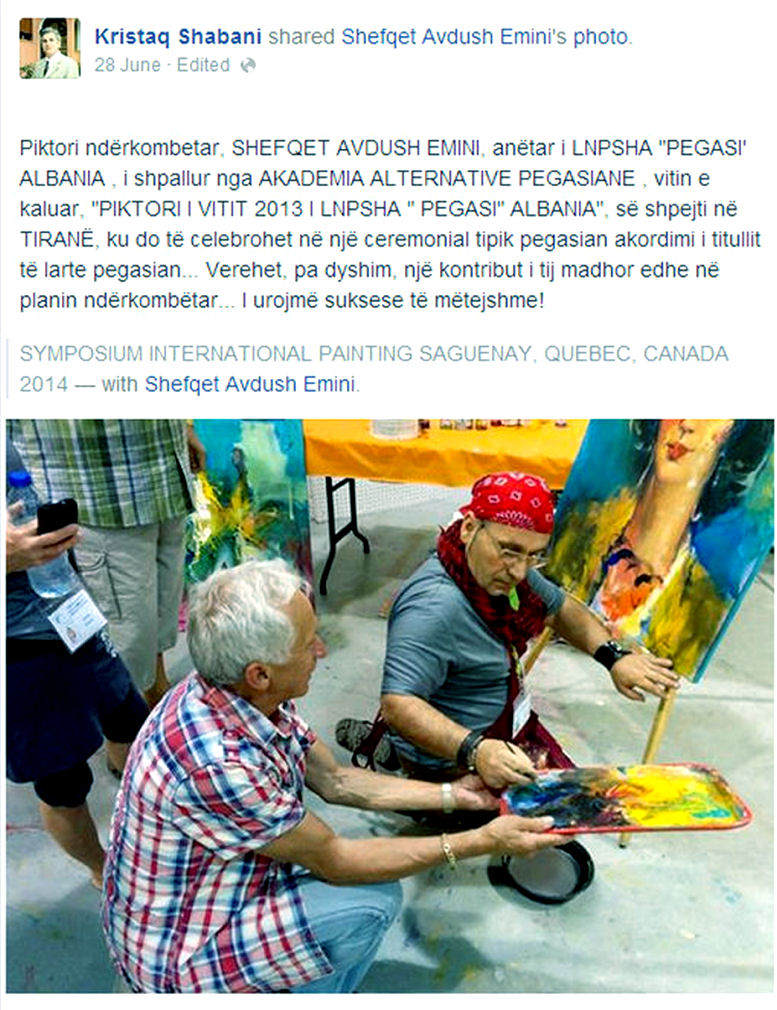
__475__.jpg?profile=RESIZE_710x)
__591__.jpg?profile=RESIZE_710x)
__246__.jpg?profile=RESIZE_710x)


No comments:
Post a Comment